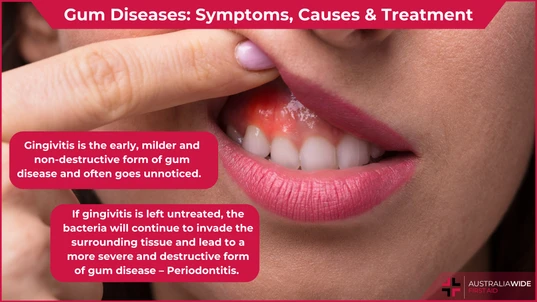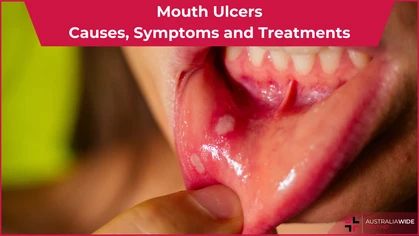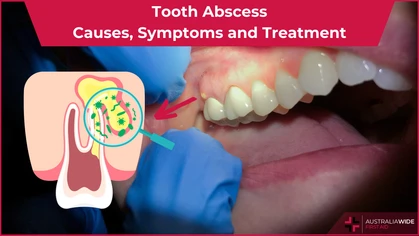Gum Diseases: Symptoms, Causes & Treatment

General Health-Related
 When it comes to oral health, most of us tend to focus on the aesthetics of our smile - the pearly whites that dazzle when we grin.
But lurking beneath that perfect smile lies a hidden threat: gum disease.
Often underestimated, gum disease can quietly wreak havoc on our oral health, and if left untreated, it can lead to serious complications.
In this article, we will look into the world of gum disease, exploring its symptoms, causes, and treatment options.
When it comes to oral health, most of us tend to focus on the aesthetics of our smile - the pearly whites that dazzle when we grin.
But lurking beneath that perfect smile lies a hidden threat: gum disease.
Often underestimated, gum disease can quietly wreak havoc on our oral health, and if left untreated, it can lead to serious complications.
In this article, we will look into the world of gum disease, exploring its symptoms, causes, and treatment options.
Understanding Gum Disease
Gum disease, also known as periodontal disease, is an inflammatory condition that affects the tissues surrounding and supporting your teeth. Our mouth is a host to millions of bacteria and microbes. While most of them are harmless, some have the potential to cause diseases. These microbes reside in plaque. Plaque is a sticky whitish-yellow film that forms on the surface of your teeth. In time, plaque has the potential to harden and become calculus or tartar. Plaque and tartar are a haven for these bacteria which lead to inflammatory changes in the gums, eventually leading to gum diseases. Gum disease normally occurs in two stages: gingivitis and periodontitis.Gingivitis
Gingivitis is the early, milder and non-destructive form of gum disease and often goes unnoticed. Symptoms:- Redness: Healthy gums are usually pink. Gingivitis can cause the gums to become redder and more swollen than usual.
- Swelling: Inflamed gums may appear swollen and puffy, especially along the gumline.
- Bleeding: One of the hallmark signs of gingivitis is bleeding gums, especially during toothbrushing or flossing. This bleeding is often painless and may start as minor pink streaks in your saliva.
- Tenderness: Gums affected by gingivitis can feel tender to the touch. They may be more sensitive when brushing or eating.
- Bad Breath (Halitosis): Gingivitis can lead to persistent bad breath due to the presence of bacteria in the mouth.
- Change in Gum Texture: Healthy gums have a firm and smooth texture. Gingivitis can cause the gums to become soft and slightly more textured.
- Increased Sensitivity: Some individuals with gingivitis may experience heightened sensitivity to hot, cold, or sweet foods and beverages.
Periodontitis
If gingivitis is left untreated, the bacteria will continue to invade the surrounding tissue and lead to a more severe and destructive form of gum disease – Periodontitis. Periodontitis causes irreversible damage to the gums and surrounding tissues of the tooth. Symptoms: As gum disease progresses to periodontitis, symptoms become more severe.- The gums appear fiery red.
- Friable and tender gums.
- Spontaneous bleeding from the gums.
- Gum recession takes place due to bone destruction.
- Formation of gum pockets.
- Persistent halitosis.
- Sensitivity to hot, cold, sweet, or salty foods and liquids as roots of the teeth become exposed.
- Loose teeth.
- In case of severe infection, there may be pus discharge from the gums.
Treatment Options for Gum Disease
Gum diseases can also be a result of certain underlying medical conditions such as diabetes and cancer. Genetics, poor nutrition, hormonal changes (puberty, pregnancy and menopause), smoking and certain medications such as anticonvulsants, anti-hypertensive drugs, etc., may also lead to gum disease. Therefore, it is vital to consult your dentist as soon as you notice any signs of gum disease. If the underlying disease seems to be the major contributing factor, your dental surgeon will promptly refer you to a medical specialist while taking measures to treat your oral health problems.- Improved Oral Hygiene: The first line of defence is to establish and maintain good oral hygiene practices. Regular brushing and flossing help remove plaque and prevent its buildup.
- Professional Dental Cleanings: Regular visits to the dentist or dental hygienist are essential for thorough cleanings that remove plaque and tartar.
- Scaling and Root Planing: This deep cleaning procedure removes plaque and tartar from below the gumline and smooths the root surfaces, promoting gum tissue healing.
- Antibiotic Therapy: In some cases, antibiotics may be prescribed to control infection and inflammation.
- Surgical Procedures: Advanced cases of periodontitis may require surgical interventions, such as flap surgery or bone and tissue grafts, to repair damaged tissues and reduce pocket depth.
- Teeth Extraction: In some cases, the teeth become severely mobile, and the only option remaining is to extract the teeth and treat the infection. Once the gums heal, you can opt for teeth replacement options such as dentures or dental implants.
Caring For Your Mouth
Gum disease is a silent dental assassin that can quietly deteriorate oral health. Recognizing the symptoms, understanding the causes, and seeking timely treatment are crucial steps in preventing the progression of this condition. By adopting good oral hygiene habits and partnering with your dentist, you can protect your gums, preserve your smile, and ensure a lifetime of dental well-being. Remember, a healthy smile starts with healthy gums.
Originally published at
https://www.australiawidefirstaid.com.au/resources/gum-diseases-symptoms-causes-treatment
as part of the Australia Wide First Aid Articles Library









